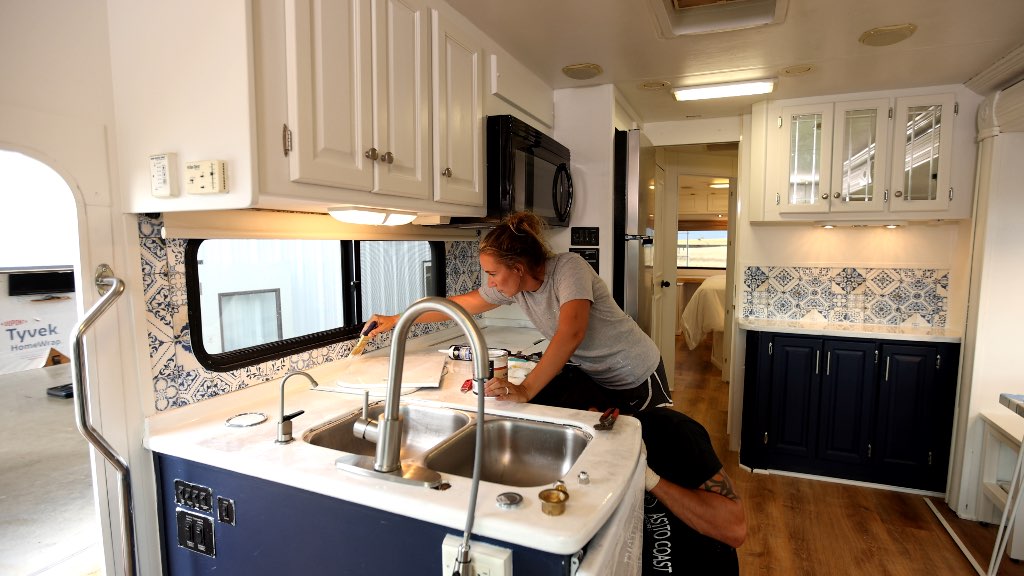Tech Q&A – June 2022
Holding Tank Indicator, Steering Wheel Wobble, Slideout Weight Capacity, Larger Propane Tank, Locking Gas Cap
Image Caption:
Holding-Tank Indicator Problem
Q: We have a 2013 Keystone Cougar 333MKS fifth wheel trailer. After I empty the black-water tank, the indicator shows that it’s still two-thirds full. Is that due to a faulty indicator?
Will Phelps, via email
A: This is a rather common problem, often caused by bath-tissue buildup on the level sensor inside the tank. Try filling the black-water tank with hot water, using a hose from your home water heater into the toilet. Just make sure the water is hot to the touch, but not scalding. Add a little automatic dishwasher detergent and make the tank about 1/2 to 3/4 full. Drive around with the trailer on curves to slosh the water sufficiently. Then dump and check the indicators.
There are some products such as Thetford Level Gauge Cleaner that help keep the sensors clean. Also, use holding-tank chemicals designed to help keep sensors clean and use RV toilet tissue, which breaks down easily in water, not household types that are somewhat “stronger.”
Problem with Leveling Jacks
Q: My fiancée and I have a 2014 Winnebago Vista 35F Class A. It has the LCI system in it. Every time we start the engine, we get a warning and beep about the jacks. I go through the sequence to reset it, and the jacks are fine and don’t act up for a while. I always have the engine running when doing the reset. Why is it occurring again and again?Michael J. Maniscalco, via email
A: THe issue as you explained it is a “Retract Timeout: Return Levelers for Service” message on the leveling control pad. Resetting the levelers requires you to press the “Enter” and “Retract” buttons simultaneously. The leveling controller (brain) used with this system monitors the hydraulic pressure on the retract side of the hydraulic system using a pressure switch. It must maintain pressure on this side because that’s what holds the jacks in the retract position. e pressure switch breaks a ground signal to the controller when it sees a pressure of under 2,150 psi. If the controller doesn’t see this signal within a set period of time, it will stop the voltage output to the pump to protect the pump motor from damage. This is when the controller will display the retract time-out error.
The controller will also monitor this pressure while the ignition is on. If, for instance, you’re driving and the pressure falls below about 1,500 psi the controller will start the pump to build pressure; if it regains the 2,150 psi, it will shut the pump off. If this cycle continues to happen (about three times) the system will lockout and trigger the error code.
There are a few reasons the system might lose pressure:
1. A bypassing leveling jack. Fluid will pass from the retract side of the jack to the extend side.
2. The pump is bypassing internally, which will prevent the pump from building pressure.
3. There’s an external fluid leak.
4. Low fluid level in the reservoir.
5. Faulty pressure switch (the switch is not opening when the pressure is reached).
6. This doesn’t normally throw the retract error, but all hydraulics bleed over time, so it’s possible the pressure could be below the threshold when the ignition is first turned back on after sitting for an extended period of time. When this occurs the pump will automatically run until the system rebuilds the proper pressure (within a set period of time) and will then shut off.
The pump has a place where a test gauge can be connected. An internal bypass condition in a jack can be tested by applying retract pressure while the line to the extend side is disconnected. It will push out bypassed fluid. For safety, these pressure tests should only be performed by qualified technicians. LCI is part of Lippert Components, and customer service can be reached at 574-537-8900 or via email at [email protected]. Lippert also has a good troubleshooting section on its website.
Steering-Wheel Wobble
Q: We have a 2004 Bounder diesel pusher 37U on a Freightliner chassis. It gets occasional steering-wheel wobble. It has 60,000 miles on it, and all steering components appear to be okay. Road surfaces seem to make the difference. Would a steering damper/stabilizer help?
Larry Wolfe, via email
A: This wobble is common on nonindependent suspensions with beam front axles, especially after hitting bumps. Drivers sometimes refer to this as “the death wobble.” Wear and front-end play or looseness should be checked carefully by a truck front-end shop. If everything checks out, try installing a good steering damper designed for this heavy axle.
Batteries Go Dead
Q: What causes my RV’s starting battery and coach batteries to run down when sitting for several days? The RV is hooked up to shorepower electric during that time.
Amos Hamilton, Shelby Charter Township, Michigan
A: You didn’t mention what year, make, and model motorhome you have, so I can only give you general information. Many motorhomes do not charge the engine-starting battery with the power converter while plugged into shorepower. It may only get charged by the alternator when the engine is running. You can check this easily by measuring the voltage at each battery before and after the converter is powered up by plugging in. If the voltage in each individual battery climbs above 13 volts with the converter on, it is getting charged. If not, try starting the engine (voltage should come up). If your motorhome doesn’t have a charging circuit for the engine battery when parked, get a product such as Trik-L-Start.
Motorhome batteries have slight constant parasitic draws from onboard electrical devices such as circuit boards, radio memories, alarms, etc. These draws should be limited to less than about 1/10 of an ampere. Often power draws such as compartment lights left on, etc., add to the draw. Check for draw with the batteries fully charged (around 12.6 volts). Remove the negative battery cable to each battery, one at a time. Then connect a digital ammeter set on a 10-amp scale between the negative battery post and the negative cable just removed. This should measure parasitic draw when everything is supposed to be off. If you detect a draw of more than roughly 1/10 amp, try removing fuses powered by this battery. When you disconnect a fuse and draw drops, you’ve found a culprit circuit. Check what is connected to that fuse and you found the problem.
If the batteries are getting properly charged, and there is no excess draw found, the batteries may be faulty. Take them to an RV shop or auto parts store for testing.

System Upgrades
Q: We have a 2020 25-foot Class C on a Sprinter 3500 chassis motorhome. It has a 12-gallon propane tank, but I want to exchange it with a 20-gallon propane tank. Is this doable and, if so, fairly easy to do? I also want to install three permanent 100-watt solar panels on the rooftop. Will I need to upgrade any other components with this?
Robert Castaneda, Redlands, California
A: About the closest tank size I know of to what you are asking about is the 24.2-gallon Manchester permanent horizontal-mount ASME propane tank. I don’t know if you have room under your coach for one, nor if the added weight will cause an imbalance or overload situation. Additionally, the installed cost will be more than $1,000. You might consider carrying a 5-gallon barbecue-style propane cylinder properly secured in a storage compartment instead and have a connection pigtail installed so you can take it out and connect when needed. These propane-connection adapters are available at propane and RV parts centers.
As for the solar, you didn’t mention what brand or model coach you have, so I suggest you work with an experienced RV solar installer and make sure there is room for all panels, that they are mounted properly, and won’t cause roof leaks. If you start with bare solar panels, you’ll also need to use a charge controller that regulates the solar charging voltage going to the batteries. Complete solar charging kits, with suitably matched components, can be had from several suppliers such as Go Power!, available at Camping World. A battery upgrade may also be in the works, so check with the solar component supplier for specific advice to fit your situation.
Fridge Madness
Q: I have a new 2022 Entegra Esteem 29V Class C motorhome equipped with a Norcold refrigerator. When the fridge transfers from electric to propane, it displays a blinking red light and the propane icon. I can hear a puffinng sound, like it is having problems getting propane. Any ideas on this?
Rodger Borge, Eagle, Idaho
A: You need to count the blinks, as Norcold uses a blinking trouble code. Count how many times it blinks every second until it pauses for five seconds. Then look up codes on page 12 of this online document.
It’s likely that DC voltage is low at the fridge. It must be at least 10.5 volts for normal operation, or the gas valve may not open. Also, have the gas pressure checked by an RV shop or propane specialist. It should be 10.5–11.5 inches of water column.
Single Rear Wheel vs. Dually
Q: I just finished reading an article about big super-duty pickups, but there was no mention or advice on when to upgrade to dual rear wheels. What are the pros and cons and your recommendations?
JB Beaver, via email
A: Pickups with dual rear wheels (DRW) have higher rear gross axle weight ratings (GAWR) than single-rear-wheel (SRW) pickups. They are much more stable on the road when towing heavy trailers or top-heavy slidein truck campers compared to a SWR truck. A rear tire failure is also less likely to cause a loss of control on a DRW. However, initial cost of a DRW truck is usually higher, tire replacement is costlier, fuel economy lower, and they tend to ride rougher when empty or lightly loaded. Also, they are too wide for many garages and parking spaces, and the wide rear fenders tend to get banged up a lot if the driver isn’t careful.
Therefore, most RVers choose a DRW pickup if the pin weight or tongue weight of their trailer is too high for a SRW truck. The last part of the calculation is the empty weight on the rear axle. You’ll need to use a truck scale to determine actual weight, with full fuel and passengers. Subtract the empty weight from the rear GAWR to determine available payload for pin weight.
If you don’t know the tongue/pin weight of a trailer, you can estimate by using 18% of the gross vehicle weight rating (GVWR) of the trailer for fifth wheels, or 12% for conventional travel trailers. Pin weight is centered over the rear axle centerline, so almost all of the pin weight will go on the rear axle. Leave a safety margin, too. Conventional trailer hitches are far aft of the axle and have a leverage effect which lifts weight off the front axle and adds it to the rear, above and beyond tongue weight.
Towing a Hyundai Santa Fe
Q: I have a 2018 Winnebago Aspect, and I want to tow my 2020 Hyundai Santa Fe. It has front-wheel drive, so it will need to be lifted on the front axle. I would like to know what tow dolly you would recommend. Roadmaster has an adjustable tow dolly, and it has electric brakes.
Larry Hall, via email
A: The 2020 Hyundai Santa Fe is not approved by the manufacturer for flat towing, so you are correct in looking for a tow dolly to carry the front wheels. I prefer to avoid making brand recommendations, and there are a number of good dollies. However, Roadmaster has a lot of experience in towing products and should be a satisfactory choice because you seem to like its features.
Locking Gas Cap
Q: We have a 2019 Coachmen Leprechaun 260DS. The coach is on a 2018 Chevy 4500 Express cutaway chassis. We’ve been experiencing some fuel theft where we store the unit. I’ve tried through GMC and Chevy to locate a locking gas cap for this chassis, and I’m having zero luck. I’ve found them for the 3500 chassis, but neither Chevy nor GMC will say if they are interchangeable.
Daniel Hills, Covina, California
A: Most recent-era vehicles use the same type of threaded gas caps. Therefore, you should be able to easily find a locking cap at most auto parts stores. You can try it right there. Enclosed fuel doors are not very practical on your type of vehicle because of the filler’s flat surface mounting. I suggest sticking with a locking cap.
Slideout Weight Capability
Q: My question is about weight limits of RV slideouts. I have inherited my parents’ 36-foot 2006 Alfa See Ya! Class A motorhome. I’m renovating the interior to make it “mine.” I want to swap out the four independent, high-backed dining chairs for bench seating so I can add storage under the bench seats. Will the added weight be too much? The dining area is in the main slideout. There is also an original couch that folds down into a queen-size bed in the same slideout. I don’t plan to store heavy tools in the benches, but I can’t find information regarding load limits for slideouts.
Teresa Brown, Clio, Michigan
A: RV manufacturers don’t normally publish weight limits on slideouts, which is likely why you didn’t find any. Designers have to build in a safety margin to allow for heavy objects and people to be accommodated on the slideout rooms. Based on your description, the modifications should probably be within the practical limits of the slideout, assuming you store lightweight items such as blankets and pillows under the bench. Many such slideouts are equipped with the dinette bench seats you have in mind, so your plan is sound.
Unfortunately, Alfa went out of business in March 2008 so you cannot contact the manufacturer for engineering information. You may be able to get information or ideas from other Alfa owners in an online support group.
Stone Bennett Shifter
Q: I have a 1990 Sportscoach 34-foot diesel pusher with an Allison transmission. It is on a Spartan chassis and has 70,000 miles on it. It has a Stone Bennett air shifter that is on the fritz. I have tried to find a shop to service and/or replace it. The few places that carry it have not answered my emails, and those that don’t say they know nothing about it. Any information would be greatly appreciated.
Jim Jensen, Big Lake, Minnesota
A: Check out United Transmission Xchange (utxchange.com, 800-527-1637) in San Bernardino, California, and ask for Donnie. These shifters are fairly simple and can be cleaned out. You may be able to clean up the shifter internally and check the air system. If there is oil coming into it, then it means that a compressor rebuild is due. If there’s water and crud but not much oil, check the air dryer.
Have a Question?
Looking for answers on all things RV, including systems, engines, accessories, or construction? Submit it to our expert at [email protected] and it may be selected for publication. You must include your name, city and state, phone number (will not be published), and type and model of your RV.





